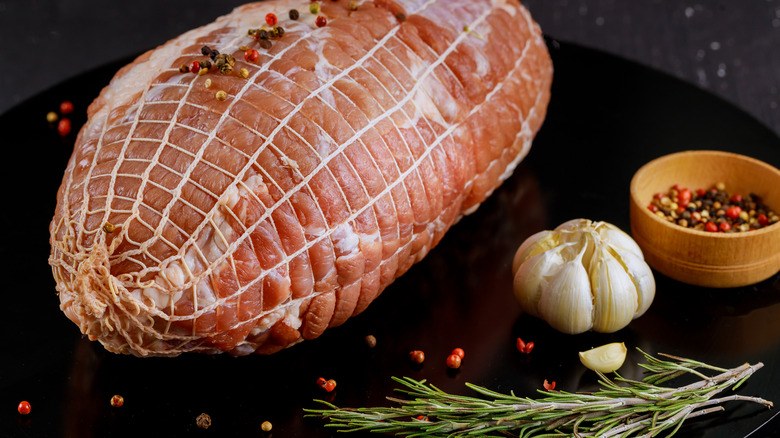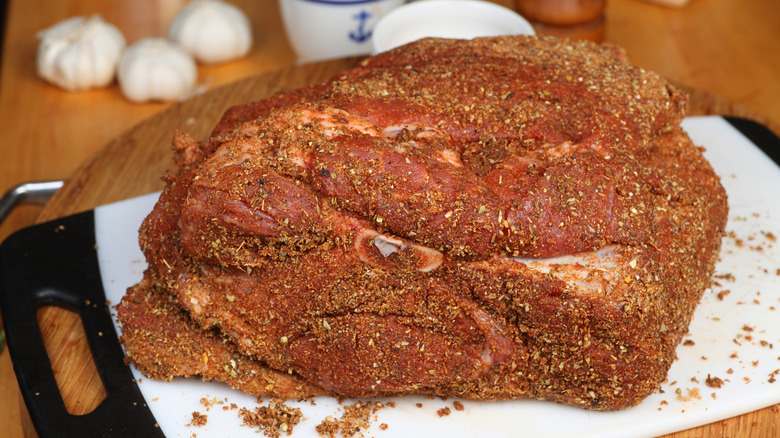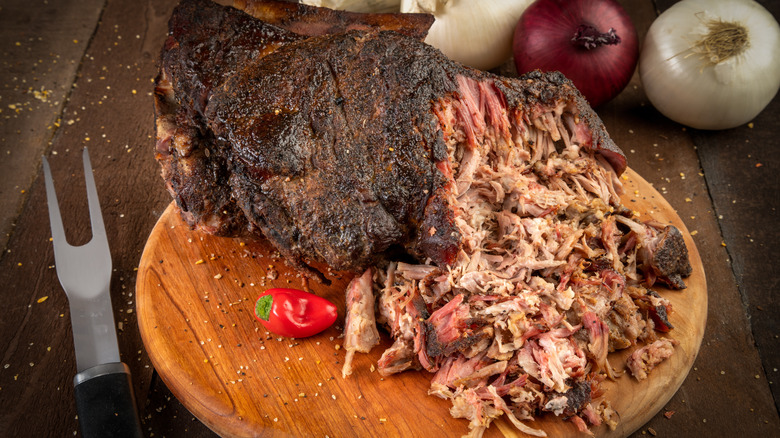The Main Difference Between Pork Butt And Shoulder
As you prepare for an upcoming holiday or family dinner, you might find yourself standing in front of a meat display deciding between a pork shoulder and a pork butt. The two cuts typically vary slightly in size, thickness, and fat content, but otherwise appear to be very similar. Further muddling the distinction is the fact that if you go from one butcher counter to another, you'll likely see the same type of cuts labeled with different names. So, what's the actual difference between pork butt and pork shoulder besides the location identified in the name?
Well, let's back up right there because the two cuts likely don't come from where you think they do. To clarify, they both come from the shoulder. Pork butt is the meat from higher up and pork shoulder is from lower down, but while on the animal they are actually attached to one another as the same large piece of meat that's located on the upper foreleg, directly above the hock. Now that we've cleared up that common misnomer, let's delve into the other meaty differences between these cuts of pork.
Size, shape, and content
To identify the cut of meat we're discussing here, you first need to understand that both options go by several names. A pork shoulder is commonly called a picnic shoulder or a picnic roast, while a pork butt is often referred to as a Boston butt. Moving away from the label, the meat itself has varying thicknesses. Since the pork butt comes from a larger part of the animal, the cut is generally thicker, while the pork shoulder is often somewhat thinner since it's carved from the narrowed part of the shoulder right above the front leg.
In addition to thickness, the butt may be bone-in or boneless, while the shoulder is boneless and may come secured in netting. However, appearance is only part of the discussion when it comes to the difference between pork butt and pork shoulder. From a cook's perspective, taste and tenderness are crucial when deciding which one to use for incredibly flavorful pulled pork and what to select for pork mofongo.
As you may know, marbled meat is typically more tender because of the fat that's woven through the muscle of the meat. Marbling is credited for everything from flavor to texture. As it pertains to this discussion, pork butt typically has more intramuscular fat. Having said that, both cuts are fairly tough and best used for long cooking methods like roasting, preparing on the smoker, or spending the day in the slow cooker.
When to use pork butt and pork shoulder
The pork butt is typically fattier, which means a long, slow cook will break down collagen and melt the fat, creating tender meat. Most cooks agree pork butt is the better choice for popular dishes like shredded pork that can be used in sandwiches, tacos, and other dishes. It's also a good choice for soups and stews.
Pork shoulder, on the other hand, is a good choice for dishes that rely on sliced or chunky bits of pork. Choose it for dishes like Chinese BBQ pork where the meat is served sliced. You can also cube it for use in soups and stews. Pork shoulder is also preferred for recipes that call for searing the skin, which is typically left attached to the shoulder when sold.
However, while chefs have their preferences when it comes to selecting a pork butt or pork shoulder, the differences are subtle enough that you can reliably use them interchangeably with delicious results. So feel free to cook up a pulled pork shoulder if that's what you have on hand.


